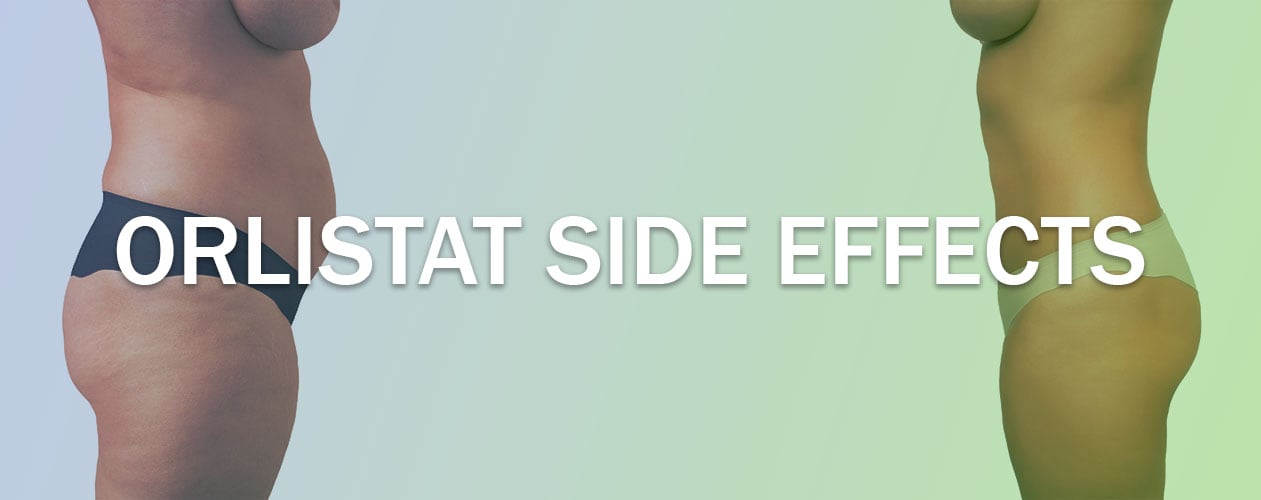Orlistat Side Effects

Background
Excessive weight has been proven to contribute to an increased risk of developing serious chronic conditions, including high blood pressure, high cholesterol, heart disease and diabetes. The consumption of excess fatty food and calories plays a significant role in the development of excess weight. While fat is an important component of a balanced diet, the consumption of excess fat contributes to excess body weight, since fat provides twice the number of calories per gram of weight as carbohydrates and protein. Reduction of dietary fat intake is one potential way of losing weight.
24% of the UK population is now considered to be obese. Everyone trying to lose weight has the same target in mind, but there are many pathways to arrive at this destination.
Orlistat was originally developed as an inhibitor of pancreatic lipase. Orlistat is the name for tetrahydrolipstatin (THL), which is a saturated derivative of lipstatin.
It is sold under the brand names Alli and Xenical. In 1998 Xenical® was launched in the EU. Alli® (marketed by GlaxoSmithKline), a lower dose formulation of Orlistat, was approved for over-the-counter (OTC) use in 2007.
Obesity-related health risk and morbidity
Evidence shows that obesity is generated by proinflammatory mechanisms that increase the risk of several chronic diseases, including hypertension, dyslipidaemia, diabetes, cardiovascular disease, asthma, sleep apnoea, osteoarthritis, and several cancers. Excessive weight may also promote gallstone formation, fatty liver, gastroesophageal reflux, menstrual abnormalities, infertility, stress incontinence, gout, carpal tunnel syndrome, and low back pain. Obese adults have more annual admissions to hospitals, more outpatient visits, higher prescription drug costs, and worse health-related quality of life than adults of normal weight do.
What is Orlistat?
Orlistat, also known as tetrahydrolipstatin is an oral prescription weight loss medication used to help obese people lose weight and maintain this weight. By inhibiting the intestinal lipase, the therapeutic use of Orlistat leads to decreased fat absorption and subsequent excretion of the unabsorbed triglycerides, cholesterol and fat. In volunteers and obese subjects, the maximal faecal fat loss depending on the dose of Orlistat and the amount of fat in the diet was about 30% of the ingested fat with doses around 360 mg/day.
Orlistat should be used together with a reduced-calorie diet that your doctor will recommend.
How does Orlistat work?
If you eat an excessive number of calories, the excess is stored as fat by the body resulting in weight gain. When you eat fat, your body breaks it down into its simplest components so that it can be absorbed. Enzymes in your intestinal tract, called lipases, help digest (or break down) fat. When you take Orlistat with meals, Orlistat attaches to the lipases and blocks them from breaking down some of the fat you have eaten. The undigested fat cannot be absorbed and is eliminated in your bowel movements. By working this way, Orlistat helps block about 30% of the fat eaten in food from being absorbed by your body.
What is Body Mass Index?
Body mass index (BMI) is a measure of body fat based on your weight in relation to your height and applies to most adult men and women aged 20 and over.
BMI is used as a screening tool to indicate whether a person is underweight, overweight, obese or a healthy weight for their height.
If a person’s BMI is out of the healthy BMI range, their health risks may increase significantly.
BMI values are age-independent and the same for both sexes. However, BMI may not correspond to the same degree of fatness in different populations due to different body proportions.
The health risks associated with an increasing BMI are continuous, and the interpretation of BMI grading in relation to risk may differ for different populations.
How to determine your Body Mass Index (BMI)
There are two ways to check your BMI:
- Use BMI calculators;
- Divide your weight in kilograms (kg) by your height in meters (m) then divide the answer by your height again to get your BMI.
Dosage and Administration
The recommended dose of Orlistat is one 120 mg capsule three times a day with each main meal containing fat (during or up to 1 hour after the meal). You should be on a nutritionally balanced, reduced-calorie diet that contains approximately 30% of calories from fat. The daily intake of fat, carbohydrate, and protein should be distributed over three main meals. If a meal is occasionally missed or contains no fat, the dose of Orlistat can be omitted. Because Orlistat has been shown to reduce the absorption of some fat-soluble vitamins and beta-carotene, you can take a multivitamin containing fat-soluble vitamins to ensure adequate nutrition. The supplement should be taken at least 2 hours before or after the administration of Orlistat, such as at bedtime.
If you are taking both Orlistat and levothyroxine therapy, administer levothyroxine and Orlistat at least 4 hours apart.
Doses above 120 mg three times a day have not been shown to provide additional benefit.
Based on faecal fat measurements, the effect of Orlistat is seen as soon as 24 to 48 hours after dosing. Upon discontinuation of therapy, faecal fat content usually returns to pre-treatment levels within 48 to 72 hours.
The safety and effectiveness of Orlistat beyond 4 years have not been determined at this time.
Does Orlistat work?
Studies have shown that, on average, Orlistat, plus a weight-reducing diet and exercise, causes more weight loss than a weight-reducing diet and exercise alone. Some people lose 10% or more of their body weight within six months with the help of Orlistat. In others, it is less effective.
One reason why Orlistat may not work is that you may think that you can relax your weight-reducing diet, and Orlistat will ‘do it all’. This is not true. Remember, Orlistat prevents only some of the fat that you eat from being absorbed (just under a third). But, if you do not keep to a healthy weight-reducing diet, and you eat more fat (chocolates, cakes, etc.), the extra fat that you eat will easily cancel out the effect of Orlistat.
How long does Orlistat take to work?
If you have lost 5% of your weight within three months, there is no restriction on how long Orlistat may be prescribed. However, most doctors will review treatment regularly and will decide if it is still appropriate for you to carry on taking Orlistat. If you continue to lose weight after six months, your doctor may advise that you continue to take Orlistat. This may be for up to 1-2 years, or longer if you have a great deal of weight to lose.
Orlistat side effects
The side effects of Orlistat are expected to form its mechanism of action on pancreatic lipase. The most troubling were faecal incontinence, oily spotting and flatus with discharge. In order to avoid the gastrointestinal events that occur during Orlistat treatment is indicated to use the concomitant prescription of psyllium hydrophilic mucilloid. Previous reports suggest that this natural fibre may be effective in lowering serum cholesterol, increasing the faecal excretion of bile acids and absorbing free fat in the intestinal lumen.
More Common
- Bladder pain;
- Body aches;
- Chills;
- A cough;
- Diarrhoea;
- Difficulty with breathing;
- Ear congestion;
- Fever;
- A general feeling of discomfort or illness;
- A headache;
- Loss of appetite;
- Loss of voice;
- Lower back or side pain;
- Muscle aches and pains;
- Nasal congestion;
- Nausea;
- A runny nose;
- Shivering;
- Sneezing;
- A sore throat;
- Sweating;
- Trouble sleeping;
- Unusual tiredness or weakness;
- Vomiting.
Less Common
- Tightness in the chest;
- Tooth or gum problems;
- Troubled breathing;
- Wheezing.
Rare
- Bloody or cloudy urine;
- Change in the hearing;
- Contagious diarrhoea;
- Dark urine;
- Difficult or painful urination;
- Earache;
- Fast heartbeat;
- Frequent urge to urinate;
- General tiredness and weakness;
- Hives;
- Hoarseness;
- Irritation;
- Itching;
- Joint pain, stiffness, or swelling;
- Large, hive-like swelling on the face, eyelids, lips, tongue, throat, hands, legs, feet, or sex organs;
- Light-coloured stools;
- Noisy breathing;
- Pain in the ears;
- Rash;
- Redness of the skin;
- Shortness of breath;
- Skin blisters;
- Swelling of the eyelids, face, lips, hands, or feet;
- Troubled swallowing;
- Upper right abdominal or stomach pain;
- Yellow eyes and skin.
Because Orlistat works by blocking the absorption of dietary fat, it is likely that you will experience some changes in bowel habits. These generally occur during the first weeks of treatment; however, they may continue throughout your use of Orlistat. These bowel changes are a natural effect of blocking the fat from being absorbed and indicate that Orlistat is working. They generally occur early in treatment, particularly after meals containing higher amounts of fat than are recommended. These symptoms are often temporary and may disappear as you continue treatment and keep to your recommended diet of meals containing no more than about 30% fat. However, these side effects may occur in some individuals over a period of 6 months or longer. In obese adolescent patients treated with Orlistat, the side effects reported were like those observed in adults.

What lifestyle changes should I consider when taking Orlistat?
You must use Orlistat with a recommended mildly reduced-calorie diet. You should also follow a program of regular physical activity, such as walking. However, before you undertake any activity or exercise program, be sure to speak with your doctor or health care professional.
How do I know if Orlistat is the appropriate drug for me?
Orlistat may be right for you if you are considerably overweight (at least 30% above ideal weight or a body mass index of 30 or greater). Orlistat may also be right for you if you are overweight (at least 20% above ideal weight or a body mass index of 27 or greater) and have other risk factors such as high blood pressure, high cholesterol, heart disease, or diabetes.
You must lose at least 5% of your weight by three months from starting Orlistat; if not, treatment should be stopped.
How does Orlistat work in adult patients?
Following one year of treatment, Orlistat in combination with diet was shown to be more effective in reducing weight than diet alone. In most cases, weight loss was gradual. Patients treated with Orlistat and a reduced-calorie diet for one year lost an average of 6 kilograms while those on a reduced-calorie diet alone lost 3 kilograms.
Orlistat for adolescents
Following one year of treatment, Orlistat in combination with diet was shown to be more effective in reducing Body Mass Index (BMI) than diet alone. A reduction in Body Mass Index is a better indicator of weight loss in children because it considers changes in weight related to growing children.
What drugs will affect Orlistat?
It is important to ask a doctor or pharmacist if it is safe for you to use Orlistat if you are also using any of the following:
- Alcohol;
- Cyclosporine;
- Digoxin;
- Fat soluble vitamin supplements and analogues;
- Glyburide;
- Levothyroxine; concomitantly treatment with Orlistat and levothyroxine should be monitored for changes in thyroid function. It is indicated to administer levothyroxine and Orlistat at least 4 hours apart;
- Nifedipine;
- Oral contraceptives;
- Phenytoin;
- Pravastatin;
- Warfarin.
This list is not complete. Other drugs may interact with Orlistat, including prescription and over-the-counter medicines, vitamins, and herbal products.
Tips on how to reduce your fat intake
- Change from butter or regular spreads to a low-fat spread;
- Choose lean cuts of meat and trim visible fat. Avoid skin on chicken and crackling on pork;
- Avoid added fat/oil when cooking – grill, poach, bake or microwave instead;
- Choose low-fat dairy foods such as semi-skimmed or skimmed milk, low-calorie yoghurts, reduced-fat cheeses and low-fat spreads;
- Choose lower-fat cook-in sauces with less than 5 g fat per 100 g sauce.
Keeping to a reduced weight
After treatment is stopped, several people who have lost weight with the help of Orlistat put weight back on. Try to anticipate this. Once you have lost some weight, you are more likely to keep your weight down if you stick to a healthy diet, exercise regularly (if you are able) and weigh yourself once a week.
The following people should not take Orlistat:
- Pregnant or breastfeeding women;
- People under the age of 18 years;
- People who have a condition where food is not absorbed properly (a malabsorption syndrome);
- People with cholestasis. This is a condition where bile does not flow properly from the liver to the duodenum.
Pharmacokinetics
Absorption
Systemic exposure to Orlistat is minimal. Following oral dosing with 360 mg 14C-Orlistat, plasma radioactivity peaked at approximately 8 hours; plasma concentrations of intact Orlistat were near the limits of detection (<5 ng/mL).
Distribution
In vitro, Orlistat was >99% bound to plasma proteins (lipoproteins and albumin were major binding proteins). Orlistat minimally partitioned into erythrocytes.
Metabolism
Based on animal data, it is likely that the metabolism of Orlistat occurs mainly within the gastrointestinal wall. Based on an oral 14C-Orlistat mass balance study in obese patients, two metabolites, M1 (4-member lactone ring hydrolysed) and M3 (M1 with N-formyl leucine moiety cleaved), accounted for approximately 42% of total radioactivity in plasma. M1 and M3 have an open β-lactone ring and extremely weak lipase inhibitory activity (1000- and 2500-fold less than Orlistat, respectively). In view of this low inhibitory activity and the low plasma levels at the therapeutic dose (average of 26 ng/mL and 108 ng/mL for M1 and M3, respectively, 2 to 4 hours after a dose), these metabolites are considered pharmacologically inconsequential. The primary metabolite M1 had a short half-life (approximately 3 hours) whereas the secondary metabolite M3 disappeared at a slower rate (half-life approximately 13.5 hours). In obese patients, steady-state plasma levels of M1, but not M3, increased in proportion to Orlistat doses.
Elimination
Following a single oral dose of 360 mg 14C-Orlistat in both normal weight and obese subjects, faecal excretion of the unabsorbed drug was found to be the major route of elimination. Orlistat and its M1 and M3 metabolites were also subject to biliary excretion. Approximately 97% of the administered radioactivity was excreted in faeces; 83% of that was found to be unchanged Orlistat. The time to reach complete excretion (faecal plus urinary) was 3 to 5 days. The disposition of Orlistat appeared to be similar between normal weight and obese subjects. Based on limited data, the half-life of the absorbed Orlistat is in the range of 1 to 2 hours.
Orlistat efficacy
Several studies have confirmed the efficacy of Orlistat in losing weight. The European Multicentre Orlistat Group conducted a double-blind study in which 688 obese individuals (average BMI, 36 kg/m2) were assigned to Orlistat therapy or placebo for 1 year, in combination with a hypocaloric diet (minimum energy intake, 1000–1200 kcal/day). At the end of the first year, they were reassigned randomly to either Orlistat or placebo for another year. At the end of the first year of the study, the mean weight loss was 10.2% for the Orlistat group and 6.1% for the placebo group. During the second year of the study, the participants who were switched to placebo gained twice as much weight as those who continued Orlistat therapy. Participants who were switched from placebo to Orlistat lost 0.9 kg more weight than in the first year of the trial.
References
- https://www.emedexpert.com/facts/orlistat-facts.shtml;
- James P. Nicolai, Junelle H. Lupiani, Andrew J. Wolf. An Integrative Approach to Obesity. https://www.sciencedirect.com/sdfe/pdf/download/eid/3-s2.0-B9780323358682000372/first-page-pdf;
- https://www.accessdata.fda.gov/drugsatfda_docs/label/2010/020766s030lbl.pdf;
- https://www.medicalnewstoday.com/info/obesity/what-is-bmi.php;
- H Cavaliere, I Floriano, G Medeiros. Gastrointestinal side effects of orlistat may be prevented by concomitant prescription of natural fibers (psyllium mucilloid). International Journal of Obesity volume 25, pages 1095–1099 (2001). DOI: 10.1038/sj.ijo.0801645;
- Suyog S. Jain, Sunita J. Ramanand, Jaiprakash B. Ramanand, Pramod B. Akat, Milind H. Patwardhan, Sachin R. Joshi. Evaluation of efficacy and safety of orlistat in obese patients. Indian J Endocrinol Metab. 2011 Apr-Jun; 15(2): 99–104. PMCID: PMC3125014
PMID: 21731866. DOI: 10.4103/2230-8210.81938; - https://patient.info/health/obesity-overweight/orlistat-weight-loss-medicine.



